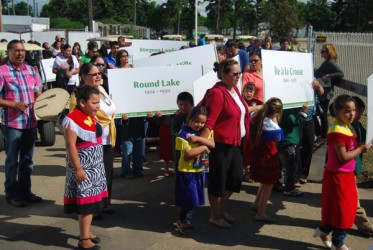Article Origin
Volume
Issue
Year
Clement Chartier is worried that the inclusion of Métis leaders in the latest Truth and Reconciliation national event held in Saskatoon June 21 to June 24 delivers the wrong message.
Sitting next to federal Aboriginal Affairs Minister John Duncan in the Circle of Reconciliation, which was comprised of representatives of the parties that signed the Indian Residential School Settlement Agreement, Chartier made it clear that the Métis people were neither included in that agreement nor in the apology delivered by Prime Minster Stephen Harper.
“The truth is that the exclusion of Métis as a people is reflected throughout this whole period,” said Chartier, president of the Métis Nation Council.
The circle, which was held June 22, the second day of the four-day TRC event, was charged with talking about the truth and how representatives will move toward reconciliation.
“On our side, we’re saying, well, sure we come forward with the truth, but to reach true reconciliation… there has to be two parties engaged. It can’t just be the Métis nation speaking to itself,” said Chartier.
In April, Metis residential school survivors gathered for the first time to share their stories, Chartier said, and he was one of those survivors.
“That helped me, not to reconcile with the perpetrators of this, but at least within myself,” he said.
Métis are only able to claim compensation if they attended an Indian residential school recognized under the agreement. Neither Métis boarding schools nor day schools are included in the settlement agreement.
In the opening ceremonies on June 21, Métis Nation-Saskatchewan President Robert Doucette thanked the Truth and Reconciliation Commission for including Ile-a-la-Crosse and Timber Bay boarding schools, both of which are in Saskatchewan, on their banners.
“That is unfinished business,” he said. ”A promise was made to the Métis to put those schools (on the approved list), to allow those survivors to begin the healing journey and they were not there.”
While Chartier appreciates the TRC’s efforts to advocate for all Aboriginal residential students, he was concerned that including the schools gave the wrong impression.
“You inadvertently may be signalling to the public that Ile-a-la-Crosse is included; (that) we are a part of (the agreement), when in fact we are not,” he said.
Chartier was a student at Ile-a-la-Crosse for 10 years. He contends that Métis students were treated just as poorly as their First Nations and Inuit counterparts. The settlement agreement was signed by the Assembly of First Nations and the Inuit Tapiriit Kanatami.
“This is a … very serious matter and I know that I’ve been attempting to bring my message forward over the past number of years and I’m not sure it’s always been successful so here I am again,” Chartier said.
Chartier has made repeated presentations in Senate hearings and has met with members of the TRC. In fact, the TRC’s interim report includes a recommendation for the parties “to address the legitimate concerns of the former students who feel unfairly left out.” Chartier was not pleased with the “general language” that alluded to Métis residential students.
Chartier challenged those in the circle to advocate for Métis residential school survivors.
“Reconciliation should be for all Aboriginal peoples and not only some Aboriginal peoples,” he said.
Photo Caption: A sign noting Ile a la Crosse residential school was included in the opening ceremonies even though it is not on the list of approved schools for compensation through the Indian Residential School Settlement Agreement.
Photo: Courtesy of the Truth and Reconciliation Commission
- 4026 views

